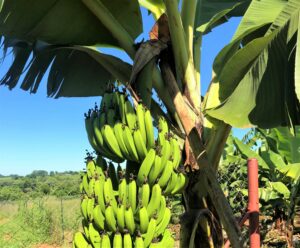Use of the preferred K-source - potassium nitrate (KNO3) - instead of potassium sulphate (SOP) or potassium chloride (KCl), increases yield, crop development and cation uptake in banana. This was shown in two field trials performed at the Technical University of Machala, Ecuador. Replacement of SOP or KCl resp. with KNO3 increased bunch weight by 29% resp. 11%, and the ratio boxes/ bunch by 21% resp. 15%.
SQM Ecuador S.A. supports the education of the next genera- tion of agronomical engineers. Correct use of potassium nitrate is one of the tools they have available to sustainably improve highly productive agriculture in the next decennia.
Two agronomy students, William Andrés Huarquila and Carlos Vital Gonzales, were supported during the development of their university thesis work by SQM colleagues Marcelo Medranda and Antonio Cabezón. Their work earned them the well-deserved title of Engineers in Agronomy, and showcased the potential of potas- sium nitrate to improve banana cultivation in Ecuador.
Trial A (W.A. Huarquila): Potassium nitrate replaced potassium sulphate in the banana plantation standard fertiliser programme. The effect on banana fruit yield and plant development was assessed.
Trial B (C.V. González): A potassium nitrate based fertiliser programme was compared to a potassium chloride based fertiliser programme with the same nutrient supply. Besides measurements of plant development and yield parameters, the nutrient uptake in the leaves was analysed.

Image 1. William Andrés Huarquilla received an award for scientific merit of his thesis at the CMB (global banana conference) in 2017

Image 2. Fertiliser application and assessment of bunches by Carlos Vital González.
Both trials were performed in commercial banana plantations, in the province of El Oro, Ecuador, with a very dry tropical forest climate (annual precipitation 699 mm, and annual temperatures 25-30°C). Soil type was silty clay (Limo arcilloso), with pH 6,7-7,1 (KCl) and or- ganic matter 4-6%, containing 50,5-62,5 ppm K (H2O 1:2 extraction). Both trials were designed in a completely randomized block design with 5 replicates of 20 plants each. Plant growth and yield param- eters were determined on marked suckers of at least 1,5 m height at the onset of the trial. Split applications of the total amount of fertilisers were soil applied every three weeks from the beginning of application, except in the control (T1), which did not receive any K-fertilisers. Recommended nutrients in farmers practice were: 400 kg N/ha, 100 kg P2O5/ha, 700 kg K2O/ha, with the N and P sourced from urea, DAP and ammonium sulphate. For the SQM programmes, the N supplied with KNO3 was compensated by lowering the amount of urea.
Trial A: Five treatments were varied by changing the source of po- tassium and total fertiliser rates, with potassium sulphate (SOP) at 100% of the recommended fertiliser rate in T2 and potassium nitrate in T3, T4 and T5, at 75%, 100% and 125% of the recommended fer- tiliser rate.
Trial B: Three treatments were varied by changing only the source of potassium, with potassium chloride (KCl) applied at 31,9 gram K/ plant/application in T2 and potassium nitrate at 31,3 gram K/plant/ application in T3.
Figure 1A

Figure 1B

Figure 1A and B. Yield parameters collected in trial A and B, expressed in percentages relative to the farmers practice (FP) treatment based on SOP (trial A) or KCl (trial B). Absolute values of the parameters at 100% of the fertiliser practice with SOP or KCl are given in the figure legend. At 100% of the recommended fertiliser dose, all parameters were higher for the programme where potassium nitrate replaced the other K-sources. Bunch weight is gross weight, inclusive of the stalk.
Figure 2A

Figure 2B

Figure 2A and B. Thicker pseudostems translate in a higher bunch weight when SOP (trial A) or KCl (trial B) is replaced by potassium nitrate in the farmers fertiliser programme (FP). Means followed by different letters are significantly separated after statistical analyses (Kruskal Wallis, p<0,05, all 6 treatments of trial A; Tukey HSD 95%, trial B).
Results
In trial A, all yield parameters were 9-29% higher for the programme where KNO3 replaced SOP at 100% of the recommended fertiliser dose. Application of KNO3 increased bunch weight and improved the thickness of the pseudostems (Figure 2A). Additionally, application of potassium nitrate allowed harvest 1 week earlier (12 weeks after flowering) compared to SOP (13 weeks after flowering).
In trial B, K application with KCl increased all yield parameters by 4-9%, but replacement of KCl with KNO3 further increased yield parameters resulting in a benefit of +10-15% compared to the application of KCl (Figure 1B). Again, KNO3 application resulted in the thickest pseudostem and the highest bunch weight (Figure 2B).



